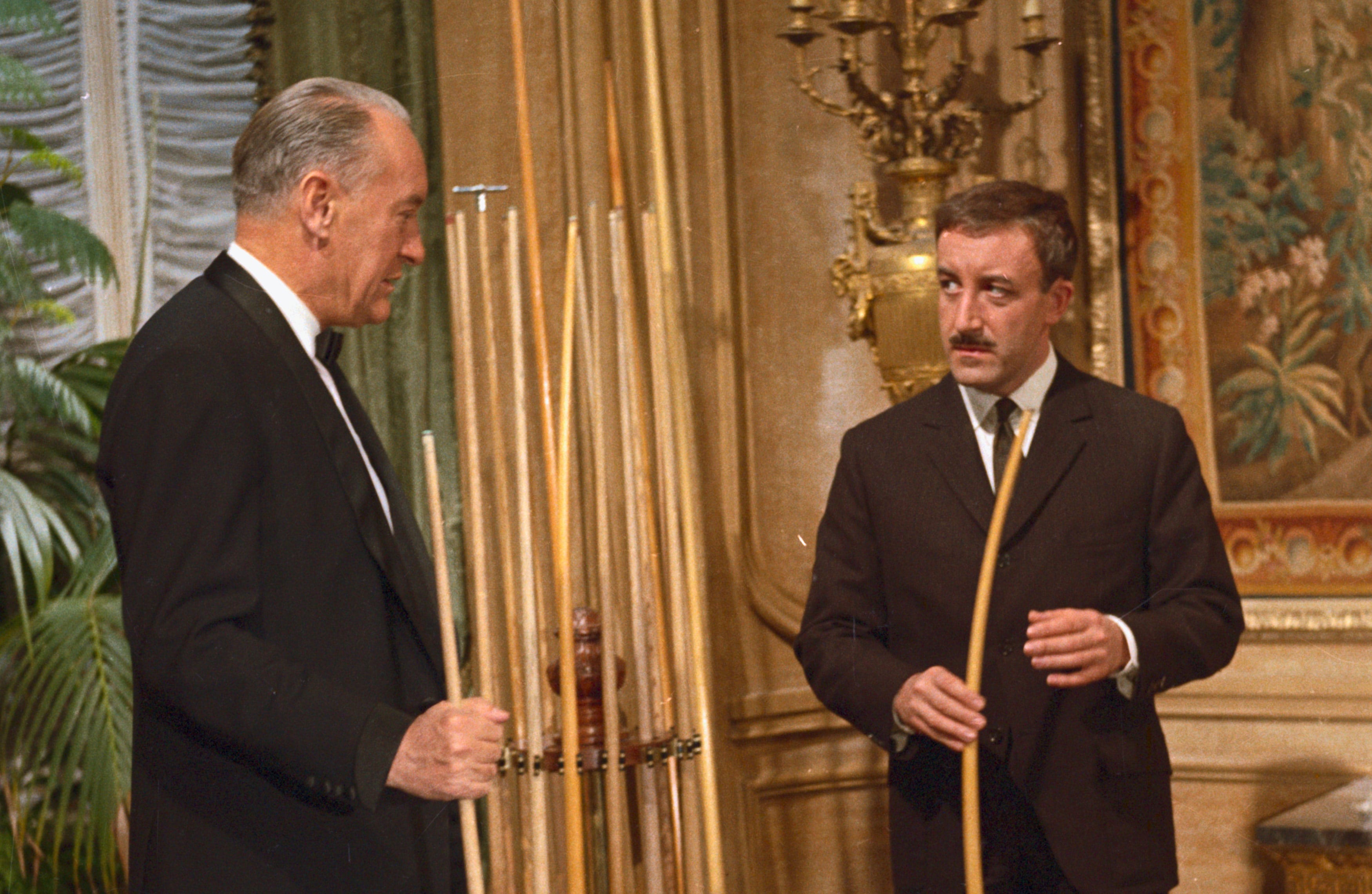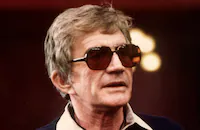A Shot in the Dark

Brief Synopsis
Cast & Crew
Blake Edwards
Peter Sellers
Elke Sommer
George Sanders
Herbert Lom
Tracy Reed
Film Details
Technical Specs

Synopsis
In Paris Maria Gambrelli, Mr. and Mrs. Benjamin Ballon's French parlormaid, is accused of killing her Spanish lover. Inspector Jacques Clouseau, accidentally assigned to the case, believes her innocent despite all the facts indicating that she is guilty. Dreyfus, Clouseau's superior, removes him from the case and arrests Maria, but, on the following day, Dreyfus learns that certain influential people wish Clouseau back on the case. Reassigned, Clouseau releases Maria and before long finds her with the gardener's dead body. Again arrested for murder, Maria is quickly released by Clouseau, who still believes in her innocence. He follows her to a nudist camp where Dudu, the Ballon's first maid, is found murdered and Maria again comes under suspicion. Lafarge, the Ballon's majordomo, is then murdered. Maria is once more arrested, and Clouseau is again removed from the case. Dreyfus reassigns the case to Clouseau, who releases Maria and takes her nightclubbing. In the course of the evening, four innocent people are killed, around the oblivious Clouseau, as a result of unsuccessful attempts on his life. The inspector gathers the six remaining suspects together in the Ballon house. They begin to accuse one another until the lights go out, and Maria and Clouseau find themselves alone. All six attempt to flee in Clouseau's car, which has been wired with a bomb intended for him. The car explodes and Clouseau has, in his own way, solved the case by the elimination of the suspects. Dreyfus goes insane because he is the real murderer, having committed the crimes to discredit the bumbling detective and thereby remove him from his staff--only to have him emerge a hero.

Director

Blake Edwards
Cast

Peter Sellers

Elke Sommer

George Sanders

Herbert Lom
Tracy Reed
Graham Stark
Andre Maranne
Douglas Wilmer
Martin Benson
Burt Kwouk
Vanda Godsell
Maurice Kaufmann
Ann Lynn
David Lodge
Moira Redmond
Reginald Beckwith
Turk Thrust
John Herrington
Jack Melford
Crew
Bert Bates
William Peter Blatty
John Bramall
Christopher Challis
Derek Cracknell
Austin Dempster
Depatie-freleng
George Dunning, Ltd.
Blake Edwards
Blake Edwards
Blake Edwards
Cecil F. Ford
Margaret Furse
Denis Johnson
Henry Mancini
Henry Mancini
Ted Mason
J. B. Smith
Michael Stringer
Robert Wells
Connie Willis
Ralph E. Winters

Videos
Movie Clip




Trailer
Hosted Intro
Film Details
Technical Specs

Articles
A Shot in the Dark
A Shot in the Dark is one of only two Inspector Clouseau movies not to have "Pink Panther" in the title (the other is 1968's Inspector Clouseau, in which neither Sellers nor Edwards was involved). That's because A Shot in the Dark was ostensibly based on both a French play, L'Idiote (1960) by Marcel Achard, and an American version by Harry Kurnitz which had opened on Broadway in 1961. The basic story of a maid who is accused of killing her Spanish lover was kept from the play, but not much else. When A Shot in the Dark went into production in late 1963, The Pink Panther was in post-production. Sellers was unhappy with the script for A Shot in the Dark and his character, so United Artists brought in his Pink Panther director, Blake Edwards. It was Edwards who had the brainstorm of putting Inspector Clouseau into the mix. He and William Peter Blatty (who would later write a novel that was made into the 1973 blockbuster The Exorcist) threw out the script and wrote a new one tailoring it to Sellers' talents. A Shot in the Dark opened just three months after The Pink Panther premiered.
The relationship between the famously neurotic, perfectionist Sellers and his director was tense. They battled constantly for supremacy. Sellers biographer Alexander Walker quotes an unnamed "friend of both men," who said that their differences "led at times to violent scenes of recrimination, and one suspected each of going out of his way to annoy the other. Blake needled Peter by his emphasis on 'A Blake Edwards Production,' and Peter persuaded himself it should be 'A Peter Sellers Film.'" Each vowed he would never work with the other again, but they made four more films together, three of them Pink Panther movies. For many fans of Sellers' Clouseau, A Shot in the Dark, made while Sellers and Edwards were still inventing and exploring the character, is the best of them.
Critics loved A Shot in the Dark and Sellers' comic inventiveness. "Blake Edwards and William Peter Blatty have fashioned an out-and-out farce that puts no tax at all on the mentality but just plunges from gag to gag," wrote Bosley Crowther in the New York Times. "And they have got Mr. Sellers to plunge with it in the joyously free and facile way that he has so carefully developed as his own special comedy technique....It is mad, but the wonderful dexterity and the air of perpetually buttressed dignity with which Mr. Sellers plays his role make what would quickly be monotonous enjoyable to the end." Time magazine agreed. "Even though the inspector occasionally palls...most customers will have reinforced a general conviction and a popular hope: that Peter Sellers is one of the funniest men alive and that the dear fellow will please get well quick." Sellers had suffered a near-fatal heart attack soon after completing A Shot in the Dark. It would be the first of several attacks, one of which ultimately killed him in 1980. At the time of his death, Sellers was 54 years old, and he and Edwards were preparing another Clouseau film, The Romance of the Pink Panther.
Producer: Blake Edwards
Director: Blake Edwards
Screenplay: Blake Edwards, William Peter Blatty, based on the play L'Idiot by Marcel Achard & Harry Kurnitz
Cinematography: Christopher Challis
Production Design: Michael Stringer
Music: Henry Mancini
Film Editing: Bert Bates, Ralph E. Winters
Cast: Peter Sellers (Jacques Clouseau), Elke Sommer (Maria Gambrelli), George Sanders (Benjamin Ballon), Herbert Lom (Charles Dreyfus), Tracy Reed (Dominique Ballon).
C-103m. Letterboxed. Closed Captioning.
by Margarita Landazuri

A Shot in the Dark
Quotes
You can have one of my cigarettes.- Maria Gambrelli
Oh, thank you.- Inspector Jacques Clouseau
You have it in backwards.- Maria Gambrelli
Oh... it tastes very bad that way.- Inspector Jacques Clouseau
Facts, Hercule, facts! Nothing matters but the facts. Without them the science of criminal investigation is nothing more than a guessing game.- Inspector Jacques Clouseau
You are forgetting the most important fact: motive.- Inspector Jacques Clouseau
He beat her.- Hercule LaJoy
He was Spanish!- Inspector Jacques Clouseau
He tore her dress off.- Hercule LaJoy
Oh, don't be ridiculous. Would you kill someone who tore your dress off?- Inspector Jacques Clouseau
Tell me, why do so many men smoke afterwards? No wonder tobacco companies get rich.- Maria Gambrelli
Trivia
Clouseau's servant is Kato in the cast list of this movie, but Cato in the sequels.
All the crimes involve members of the Ballon household. "Ballon" is French for "balloon". And at one point Clouseau disguises himself as a balloon-seller.
The character of Maria Gambrelli first appears in this film and was played by Elke Sommer. The character resurfaced in Son of the Pink Panther (1993), played this time by 'Cardinale, Claudia' , who played Princess Dala in the original Pink Panther (1964).
This film was originally meant to have been an adaptation of the stage play by Harry Kurnitz. Walter Matthau and Peter Sellers were to have been the detectives, but Sellers did not like how things were going and wanted out. United Artists brought in Blake Edwards to keep Sellers on the project. Edwards looked at the script and thought that it might be better suited to the character of Inspector Jacques Clouseau, and rewrote the entire script with a young William Peter Blatty. It was released only three months after the original _Pink Panther (1964)_ .
None of the characters in the Harry Kurnitz stage play appears in the film.
Notes
Locations filmed in Paris. Released in Great Britain in 1965.

Miscellaneous Notes
Released in United States 1995
Released in United States May 2002
Released in United States Summer June 23, 1964
Shown at the Museum of Modern Art (Screen Plays: From Broadway to Hollywood, 1920-1966) in New York City on October 15 and October 17, 1995.
Shown at Tribeca Film Festival May 8-12, 2002.
Project was originally begun by Anatole Litvak under the title "The Third Dimension."
Second film in the "Inspector Clouseau" series.
Released in United States May 2002 (Shown at Tribeca Film Festival May 8-12, 2002.)
Released in United States Summer June 23, 1964
Released in United States 1995 (Shown at the Museum of Modern Art (Screen Plays: From Broadway to Hollywood, 1920-1966) in New York City on October 15 and October 17, 1995.)
















